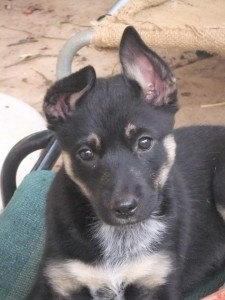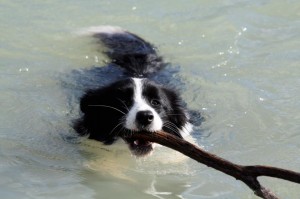McGreevy on Classical Conditioning
This post is part of the McGreevy seminar series. Click here for the index.
This is a short summary on Classical Conditioning, as mentioned at Paul McGreevy’s recent seminar. For a more inclusive approach, please see this post from the Reactive Champion blog or Roger Abrantes’ post on “Unveiling the myth of reinforcers and punishers“.
Classical conditioning is also called Pavlovian conditioning. In classical conditioning, an association is made between two things. That is, when I hear the letterbox clang, I associate this with getting mail. When I walk past a bakery, I associate the smell with the taste of bread. When I see dark grey clouds, I think about the forthcoming rain. Sounds, colours, smells, pretty much anything, can be associated with other things.

Puppies are more likely to experience novel events and form strong associations. (Picture courtesy of Yorke Peninsula Puppy Rescue.)
Simply, classical conditioning makes the world predictable with “X goes with Y”, where ‘X’ could be anything and ‘Y’ could be anything else.
The more closely X is followed by Y, the more likely the association will be made.
When an animal makes an association (i.e. “X goes with Y”), and it forms an involuntary response, it is has said to be classically conditioned. Often, trainers feed dog-reactive-dogs in the presence of other dogs in order to have them associate ‘dogs with food’ and, involuntarily, feel more comfortable in the presence of other dogs.
When this association is novel, then the association is more rapidly acquired because there are no ‘undoings’ to be done. For dogs, puppies that are attacked by a particular breed may associate that breed (appearance, smell, colouration, body language) with being attacked, and have a fearful response as a result of this classical conditioning. A single bad experience, if novel enough, can elicit a fearful response for life (this is also true of operant conditioning).
Sometimes, dogs may make associations based on slight cues in the environment. This can lead to them responding in ways that can confuse human counterparts. Indeed, during any training and any interactions, classical conditioning may occur. Some are simple: The dog may associate the car with fun. Some are more complex: The dog associates your brother with thunderstorms, because that was the context on first meeting.
McGreevy provided some insights into other animals and the classical conditioning that is typical in their species. He described how stallions used at stud often associate particular bridle gear with sex, and so become aroused and otherwise agitated when that bridle gear is brought out. (My stud dog associates ‘new little wirey dog’ in the house with sex, which is not always great when it’s actually a male foster dog!) McGreevy also mentioned how dairy cows associate the sound of the vacuum with releasing milk, and sometimes release milk prematurely upon hearing that sound.
Further reading: Ian Dunbar on Classical Conditioning
This post is part of the McGreevy seminar series. Click here for the index.




